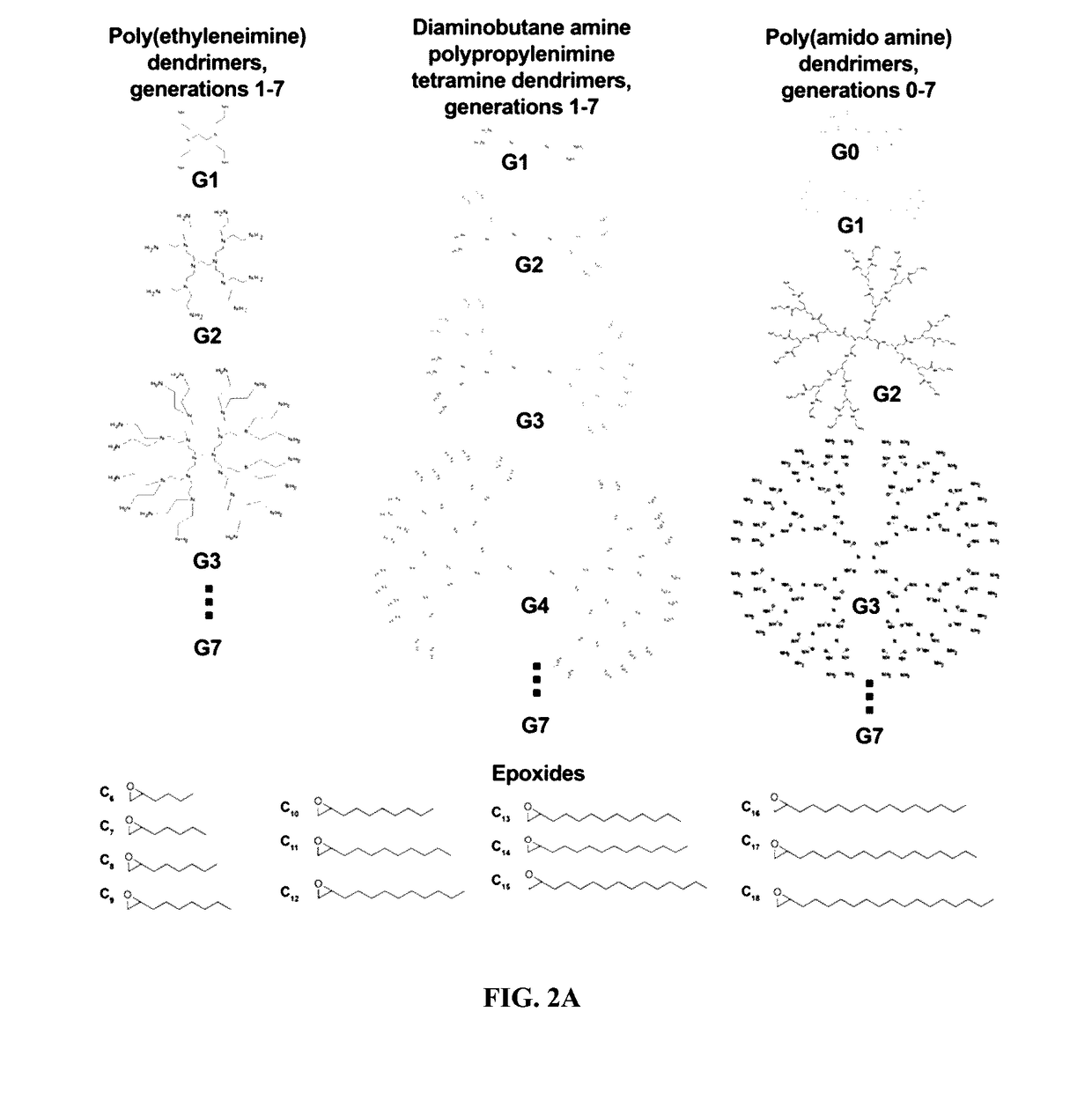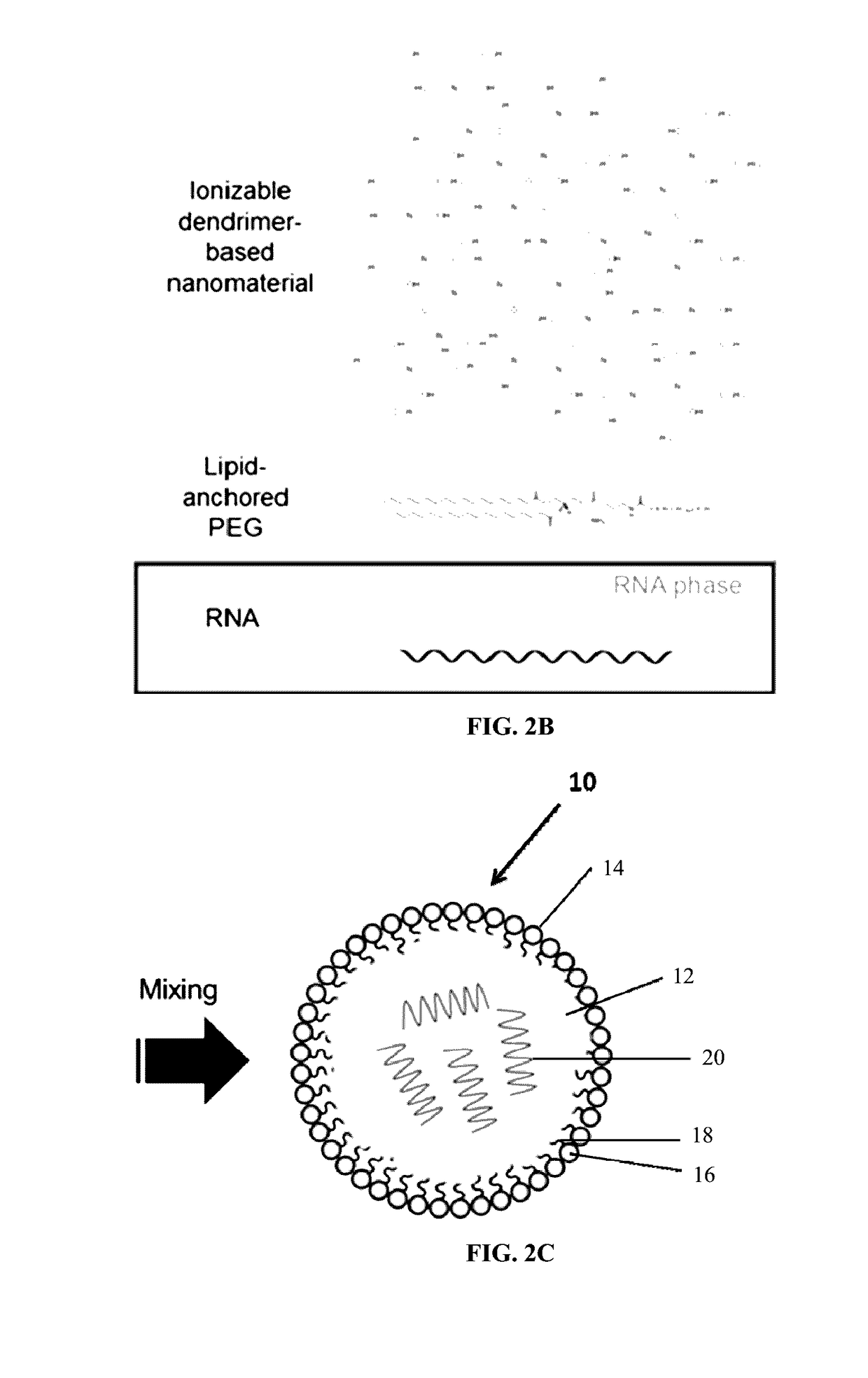Compositions and methods for modified dendrimer nanoparticle delivery
- Summary
- Abstract
- Description
- Claims
- Application Information
AI Technical Summary
Benefits of technology
Problems solved by technology
Method used
Image
Examples
example 1
Construction of MDNPs Containing RNA Molecules for Use as Vaccines
Materials and Methods
[0325]Plasmids and Cloning
[0326]Conventional mRNAs, without chemical modification or stabilizing UTRs, were produced by cloning the antigen of interest into the HindIII and XbaI sites in the multiple cloning site of the mammalian expression plasmid pcDNA3-EGFP (a gift from Doug Golenbock (Addgene plasmid #13031) after excision of the eGFP coding sequence flanked by those restriction sequences. PCR products containing a Kozak consensus sequence (Kozak, M. Nucleic Acids Res 15, 8125-8148 (1987)) followed by the desired antigen coding sequence were inserted using the In-Fusion (Clontech Laboratories Inc.) cloning kit.
[0327]Venezuelan Equine Encephalitis Virus (VEEV)
[0328]VEEV replicon RNA vectors were produced by cloning antigens into the VEEV replicon plasmid pTK126, based on the wild-type TRD strain, kindly provided by Tasuku Kitada (Weiss Lab, MIT) to replace the mVenus coding sequence that lays d...
example 2
Modified Dendrimer RNA Nanoparticles are Stable in Serum at 37° C. and at 4° C.
Materials and Methods
[0352]Statistical Analyses
[0353]Means were compared by ANOVA with Tukey multiple comparison corrections. For survival curves, the Mantel-Cox test was used. P values below 0.05 were considered statistically significant.
[0354]Primary Cells and Cell Lines
[0355]C2Cl2 mouse myoblasts (ATCC CRL-1772) and L6 rat myoblasts (ATCC CRL-1458) were maintained in DMEM supplemented with 10% FBS. For differentiation, C2Cl2 cells were allowed to grow to confluency and then maintained in DMEM supplemented with 10% horse serum (Sigma) for five days, by which point the majority of the monolayer exhibited large contiguous fused myotube-like structures. DC2.4 cells were maintained in RPMI supplemented with 10% inactivated FBS, 1% L-glutamine, and 60 uM 2-mercaptoethanol. Mouse embryonic fibroblasts (MEFs) were obtained from Lonza and maintained in DMEM supplemented with 10% FBS. Human foreskin fibroblasts ...
example 3
MDNPs (MDNP) Containing RNA Selectively Target and Kill Cancer Cells
Materials and Methods
[0371]The MDNP platform was used to create and assess an anti-cancer vaccine using a cancer tumor model involving cOVA-expressing tumor cells. The MDNP platform was used to vaccine mice with either conventional cOVA-expressing mRNA or Semliki Forest Virus (SFV) replicons, or Trp1-expressing VEEV replicon.
[0372]RNA Design and Expression
[0373]To create an ideal cancer therapy, bioinformatics is used to sequence each patient's unique tumor exome to identify “neoantigens”. Corresponding mRNAs of these neoantigens are used to generate the antigens necessary to create immunity. Tumor cells expressing the model antigen OVA serve as a model system to test immunization against a non-wild-type protein sequence expressed in a tumor. Immunization can also be performed against antigens that are not mutated, but selectively enriched in the cancer cell type (e.g., Trp1 in melanomas). Using known methods, one o...
PUM
| Property | Measurement | Unit |
|---|---|---|
| Mass | aaaaa | aaaaa |
| Mass | aaaaa | aaaaa |
| Mass | aaaaa | aaaaa |
Abstract
Description
Claims
Application Information
 Login to View More
Login to View More - R&D Engineer
- R&D Manager
- IP Professional
- Industry Leading Data Capabilities
- Powerful AI technology
- Patent DNA Extraction
Browse by: Latest US Patents, China's latest patents, Technical Efficacy Thesaurus, Application Domain, Technology Topic, Popular Technical Reports.
© 2024 PatSnap. All rights reserved.Legal|Privacy policy|Modern Slavery Act Transparency Statement|Sitemap|About US| Contact US: help@patsnap.com










